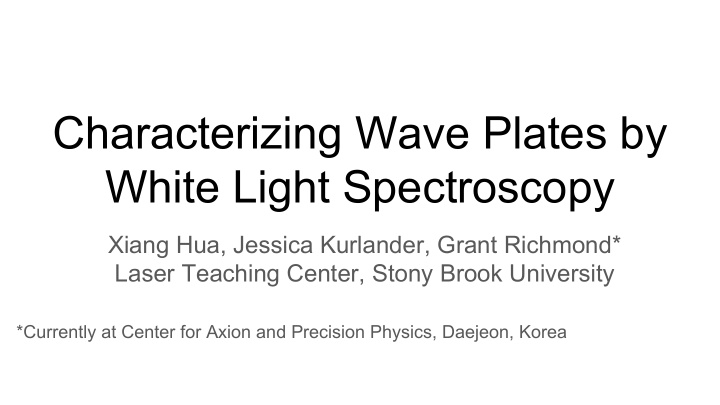



Characterizing Wave Plates by White Light Spectroscopy Xiang Hua, Jessica Kurlander, Grant Richmond* Laser Teaching Center, Stony Brook University *Currently at Center for Axion and Precision Physics, Daejeon, Korea
What is a wave plate? Optical element made of birefringent materials. Adds a phase shift between the two polarization basis vectors These basis vectors are determined by the orientation of the fast and slow axis of the material Phase shift, � , depends on birefringence (Δn): difference in index of refraction of the fast and slow axis
How to find the axes of a Wave Plate? What you will need: two linear polarizers and a birefringent material Set polarizers to extinction Rotate birefringent material between polarizers and observe results
Observing Circularly Polarized Light
Babinet Compensator Pros: acts as a variable wave-plate to give any desired phase shift (retardance), works over large wavelength range Cons: quartz prisms are expensive, can be made but needs to be very precisely aligned, needs time to be made and then shipped
Ehringhaus (Tilting) Compensator Pros: easily created (only need a waveplate and rotational mount) and inexpensive Cons: reflectivity changes with respect to incidence angle, high order plate will have large phase shift with small change in incidence angle, very sensitive to small changes in optical axis orientation, allows us to determine phase retardance of an unknown element for a single wavelength at a time
Approach for Seeing Phase Shift Polarizer Unknown Polarizer 0 deg 0 deg
Spectrometer Allows us to observe how wave plate affects light at many wavelengths using a broadband source Using an OceanOptics USB2000+ spectrometer, can collect data for wavelengths from 339nm to 1024nm, with a resolution of 0.282nm, Signal/Noise = 250/1
Light Sources There are three different light sources in our experiment: white light source, blue light source and black light source. White light is provided by The OSL1 High Intensity Fiber Light Source. This source has tunable intensity. Blue light is provided by a blue LED. Black light is provided by a black light flashlight.
Setup
Composite Transmission Spectrum
Spectral technique for determining wave-plate characteristics** Find the intersection points of the normalized transmission spectrum at an arbitrary transmission percentage Label the location of these points: λ i **W. Wang, J. Chen, Z. Liu. “Spectral technique for measuring phase retardation of a wave plate.” Chinese Optics Letters. 10 Jan 2015.
Putting technique to the test First tested with a known wave-plate (½-wave at 830nm) but it did not yield expected results of a ½-wave plate Thicknesses also varied when using different sets of intersection points’ wavelengths. We tried to average the thicknesses but it still did not yield the results we would expect Tried minimization method to get better estimate of thickness of the element
Minimization Technique Phase shift: � = 2πΔn*d/λ Find the thickness for λ=830nm: Minimize the integer N for peak wavelengths:
Comparing the two methods We then compared the two methods and plotted them against each other
What if we don’t know the material of the element? Assume birefringence variation across the range of wavelengths is small
Determining other Characteristics Rest of the characteristics are determined with thickness calculations Absolute Phase: Relative Phase: Order:
Retardance Characteristics for 830nm HWP
Unknown 2 This was an element we had previously tested to be a high-order ½-wave plate at 460nm
Unknown 3 This element we had previously determined to be a zero/low order ¼-wave for 460 nm. Since this is low/zero order, our intersection points technique does not apply. We analyzed the data to determine this is a ½-wave for 520 nm and a ¼-wave for 433nm and 900nm Upon rotating the analyzer transmission remained constant at 433nm and 900nm At 520nm the transmission went from 0 to 1 changing the polarizers from pass to cross polarizations
Unknown 4 This was an element we had previously tested to be a high-order quarter wave plate at 633 nm
In the Future Bring back the Ehringhaus compensator and apply the spectral technique to it across a range of angular tilt. Perhaps create a simple manual for people to quickly use this setup to determine the intended wavelengths of an unknown waveplate. Design a simple experiment that could be performed in an introductory optics course so students can explore the concepts of phase retardation, birefringence, and chromatic dispersion. All while learning practical lab techniques such as using a spectrum analyzer and polarizers for more than just sunglasses.
Acknowledgments We would like to thank Dr. Bentley, Dr. Noe, Dr. Cohen and Dr. Metcalf for mentoring us and our work is supported by LTC
How we normalize With the low intensities of our blue and black light spectrums, we normalize in such a way to reduce the effect of noise A= GTs at full pass with the WP B= GTs at full pass C= 1st GT D= WP only E= GTs crossed (background signal) *All values are in counts of the spectrum analyzer
Recommend
More recommend